Performance Evaluation in a Fully Purged High-Pressure Turbine Stage Using Seed Gas Concentration Measurements †
Abstract
1. Introduction
2. Experimental Setup
2.1. Transonic Test Turbine Facility (TTTF)
2.2. Test Vehicle and Operating Conditions
3. Measurement Techniques
3.1. Aerodynamic Measurements
3.2. Concentration Measurements
4. Methodology
4.1. Efficiency Calculation
4.1.1. Turbine Efficiency–Based on Uniform Purge Assumption (UP)
4.1.2. Turbine Efficiency–Based on Measured Purge Distribution (PD)
4.2. Efficiency Calculation
5. Results and Discussion
5.1. HPT Stage Efficiency 2D Map
5.2. Efficiency Definition Effect
5.3. Purge Flow Variation Effect
6. Conclusions
Author Contributions
Funding
Institutional Review Board Statement
Informed Consent Statement
Data Availability Statement
Acknowledgments
Conflicts of Interest
Nomenclature
| Abbreviations | |
| HPT, LPT | high-pressure, low-pressure turbine |
| TVF | turbine vane frame |
| PFR | purge flow ratio |
| FHP | five-hole probe |
| LE | leading edge |
| LPV, UPV | lower, upper passage vortex |
| TLF | tip leakage flow |
| SV | scraping vortex |
| PD | purge distribution |
| UP | uniform purge |
| UHC, USC | upstream hub/shroud cavity |
| Symbols | |
| , | radial, tangential coordinate |
| A, B, C, D | Plane A, B, C, D |
| , , | total pressure, temperature, enthalpy |
| axial length | |
| specific heat capacity at constant pressure | |
| efficiency | |
| concentration | |
| mass flow | |
| effectiveness | |
| Reynolds number | |
| , | absolute velocity, Mach number |
| , | density, dynamic viscosity |
| entropy | |
| Subscripts and Superscripts | |
| 1, 2 | HPT stage, LPT stage |
| k, l | cavity indices |
| 0, ms, s | cavity, mainstream, sample |
| c, fm | combined, fully mixed |
| ¯ | average |
| is, ad | isentropic, adiabatic |
| vol | volumetric |
References
- Hartsel, J. Prediction of effects of mass-transfer cooling on the blade-row efficiency of turbine airfoils. In Proceedings of the 10th Aerospace Sciences Meeting, San Diego, CA, USA, 17–19 January 1972. [Google Scholar] [CrossRef]
- Young, J.B.; Horlock, J.H. Defining the Efficiency of a Cooled Turbine. J. Turbomach. 2006, 128, 658–667. [Google Scholar] [CrossRef]
- Berdanier, R.A. Calculating Cooled Turbine Efficiency with Weighted Cooling Flow Distributions. J. Turbomach. 2023, 145, 061007. [Google Scholar] [CrossRef]
- Ong, J.; Miller, R.J.; Uchida, S. The Effect of Coolant Injection on the Endwall Flow of a High Pressure Turbine. J. Turbomach. 2012, 134, 051003. [Google Scholar] [CrossRef]
- Jenny, P.; Abhari, R.S.; Rose, M.G.; Brettschneider, M.; Engel, K.; Gier, J. Unsteady Rotor Hub Passage Vortex Behavior in the Presence of Purge Flow in an Axial Low Pressure Turbine. J. Turbomach. 2013, 135, 051022. [Google Scholar] [CrossRef]
- Regina, K.; Kalfas, A.I.; Abhari, R.S. Experimental Investigation of Purge Flow Effects on a High Pressure Turbine Stage. J. Turbomach. 2014, 137, 041006. [Google Scholar] [CrossRef]
- Dahlqvist, J.E.; Fridh, J. Experimental flow and performance investigations of cavity purge flows in a high pressure tur-bine stage. In Proceedings of the 11th European Conference on Turbomachinery Fluid Dynamics and Thermodynamics, ETC 2015, Madrid, Spain, 23 March 2015. [Google Scholar]
- Zlatinov, M.B.; Tan, C.S.; Montgomery, M.; Islam, T.; Harris, M. Turbine Hub and Shroud Sealing Flow Loss Mechanisms. J. Turbomach. 2012, 134, 061027. [Google Scholar] [CrossRef]
- Merli, F.; Hafizovic, A.; Krajnc, N.; Schien, M.; Peters, A.; Heitmeir, F.; Göttlich, E. Aerodynamic Assessment of Turbine Center Frames and Turbine Vane Frames Under the Influence of Purge Flows. In Proceedings of the ASME Turbo Expo 2022: Turbomachinery Technical Conference and Exposition, Rotterdam, The Netherlands, 13–17 June 2022. [Google Scholar] [CrossRef]
- Merli, F.; Krajnc, N.; Hafizovic, A.; Göttlich, E. Performance Evaluation in a Fully Purged High-Pressure Turbine Stage Using Seed Gas Concentration Measurements. In Proceedings of the 15th European Turbomachinery Conference, Paper N. ETC2023-268, Budapest, Hungary, 24–28 April 2023; Available online: https://www.euroturbo.eu/publications/conference-proceedings-repository (accessed on 11 June 2023).
- Neumayer, F.; Kulhanek, G.; Pirker, H.-P.; Jericha, H.; Seyr, A.; Sanz, W. Operational Behavior of a Complex Transonic Test Turbine Facility. In Proceedings of the ASME Turbo Expo 2001: Power for Land, Sea, and Air, New Orleans, LA, USA, 4–7 June 2001. ASME Paper No. GT2000-489. [Google Scholar] [CrossRef]
- Hubinka, J.; Santner, C.; Paradiso, B.; Malzacher, F.; Göttlich, E.; Heitmeir, F. Design and construction of a two shaft test turbine for investigation of mid turbine frame flows. In Proceedings of the ISABE, Montreal, QC, Canada, 7–11 September 2009; pp. 7–11. [Google Scholar]
- Steiner, M.; Zerobin, S.; Bauinger, S.; Heitmeir, F.; Göttlich, E. Development and Commissioning of A Purge Flow System in A Two Spool Test Facility. In Proceedings of the 12th European Conference on Turbomachinery Fluid dynamics & Thermodynamics, Stockholm, Sweden, 3–7 April 2017. ETC Paper No. ETC2017-115. [Google Scholar] [CrossRef]
- Patinios, M.; Merli, F.; Hafizovic, A.; Göttlich, E. The Interaction of Purge Flows with Secondary Flow Features in Turbine Center Frames. In Proceedings of the ASME Turbo Expo 2021: Turbomachinery Technical Conference and Exposition, Online, 7–11 June 2021. [Google Scholar] [CrossRef]
- Merli, F.; Hafizovic, A.; Krajnc, N.; Schien, M.; Peters, A.; Heitmeir, F.; Göttlich, E. The Interaction of Main Stream Flow and Cavity Flows in Turbine Center Frames and Turbine Vane Frames. J. Eng. Gas Turbines Power 2022, 145, 021027. [Google Scholar] [CrossRef]
- Bell, I.H.; Wronski, J.; Quoilin, S.; Lemort, V. Pure and Pseudo-pure Fluid Thermophysical Property Evaluation and the Open-Source Thermophysical Property Library CoolProp. Ind. Eng. Chem. Res. 2014, 53, 2498–2508. [Google Scholar] [CrossRef] [PubMed]
- Holman, J.P. Experimental Methods for Engineers, 7th ed.; International ed.; McGraw-Hill: New York, NY, USA, 2001. [Google Scholar]
- De´nos, R.; Paniagua, G.; Yasa, T.; Fortugno, E. Determination of the Efficiency of a Cooled HP Turbine in a Compression Tube Facility. In Proceedings of the ASME Turbo Expo 2006: Power for Land, Sea, and Air, Barcelona, Spain, 8–11 May 2006; pp. 607–618. [Google Scholar] [CrossRef]
- Sterzinger, P.Z.; Zerobin, S.; Merli, F.; Wiesinger, L.; Peters, A.; Maini, G.; Dellacasagrande, M.; Heitmeir, F.; Göttlich, E. Impact of Varying High- and Low-Pressure Turbine Purge Flows on a Turbine Center Frame and Low-Pressure Turbine System. J. Turbomach. 2020, 142, 101011. [Google Scholar] [CrossRef]
- Zerobin, S.; Peters, A.; Bauinger, S.; Ramesh, A.B.; Steiner, M.; Heitmeir, F.; Goettlich, E. Aerodynamic Performance of Turbine Center Frames With Purge Flows—Part I: The Influence of Turbine Purge Flow Rates. J. Turbomach. 2018, 140, 061009. [Google Scholar] [CrossRef]
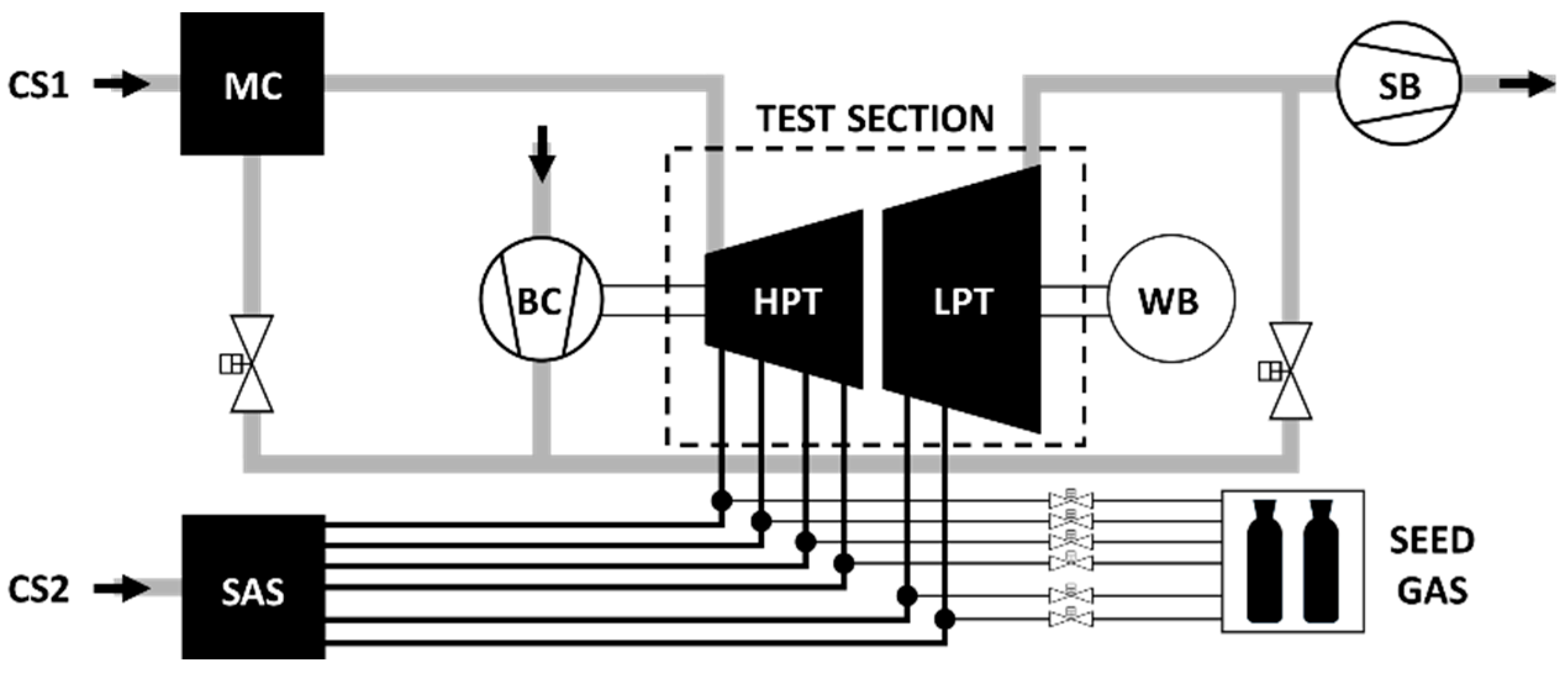
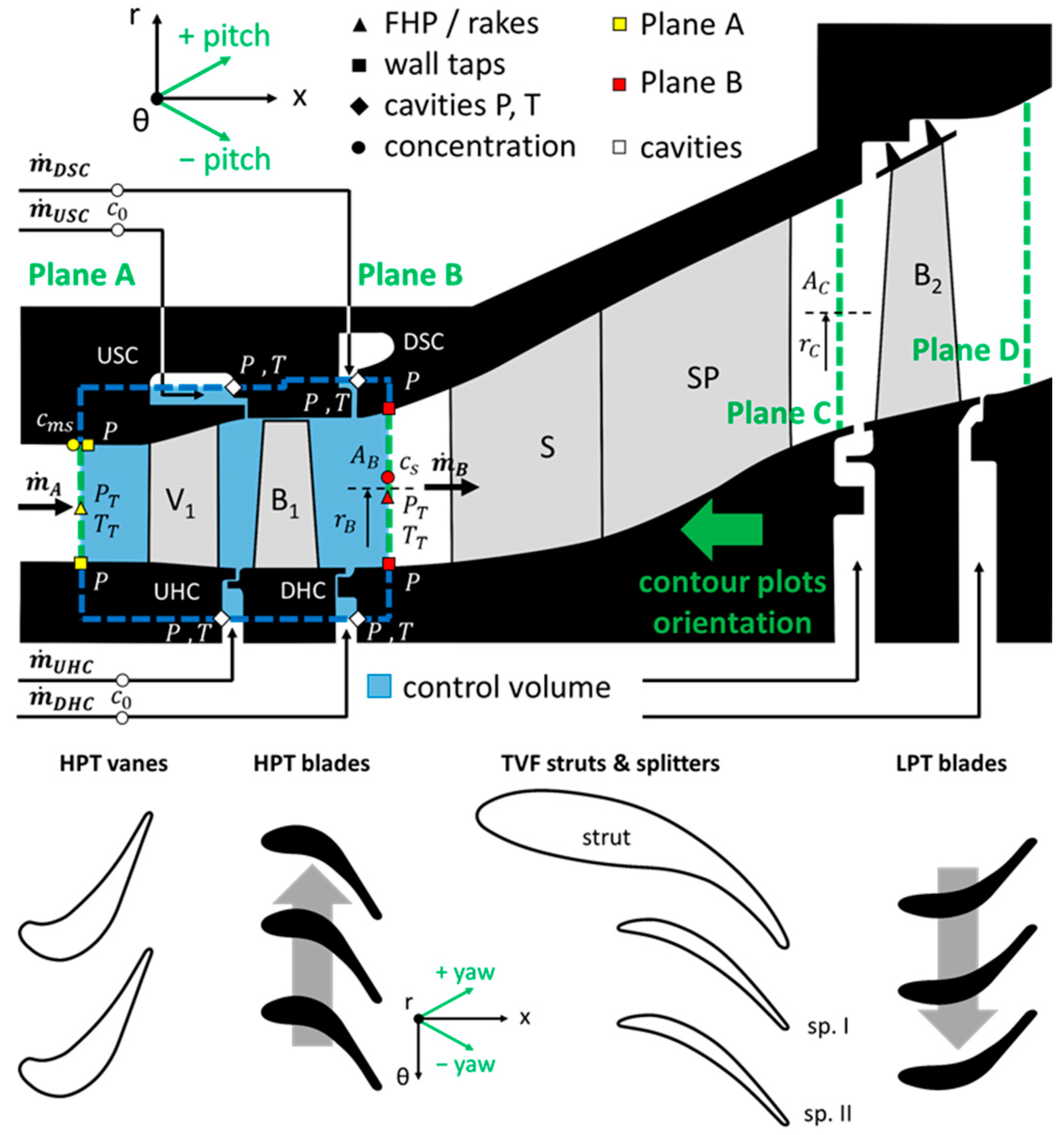
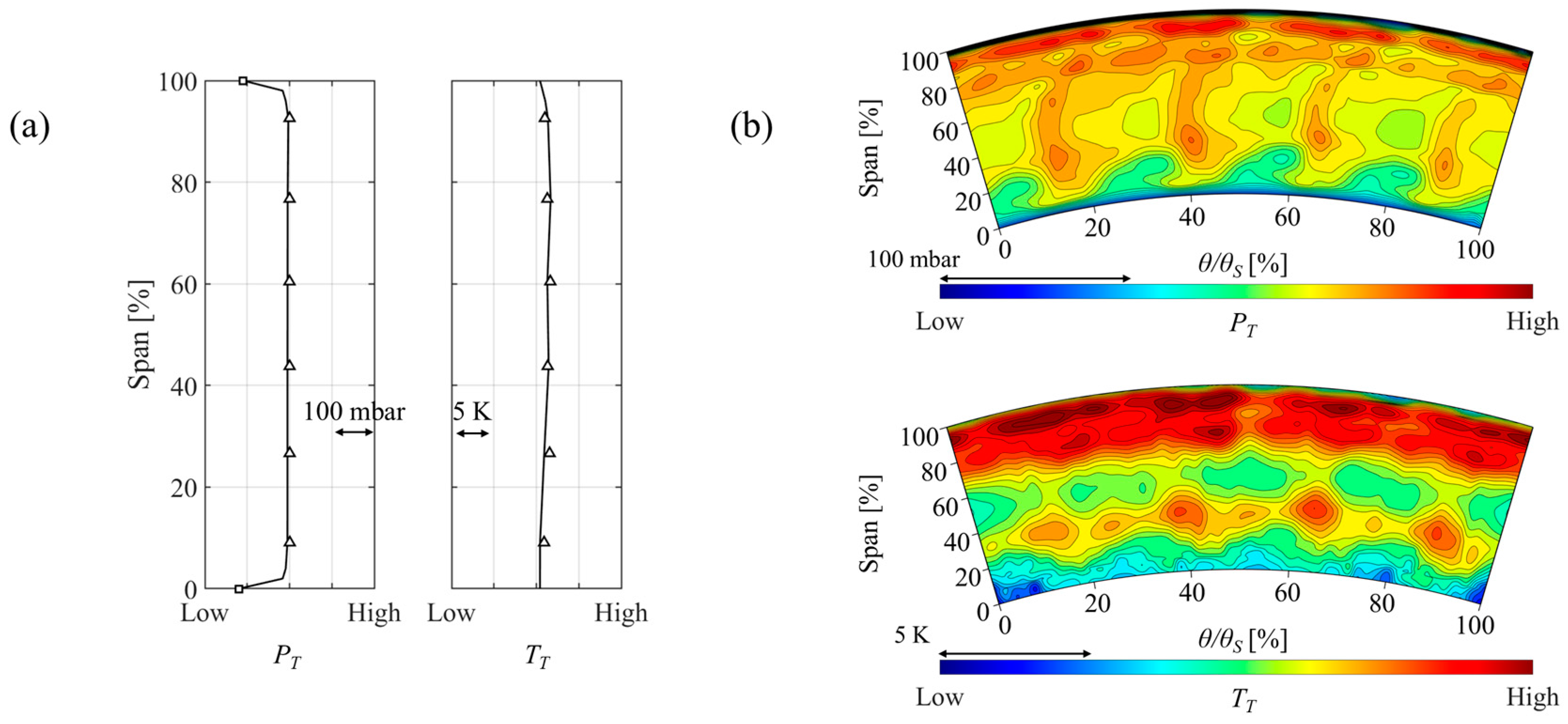

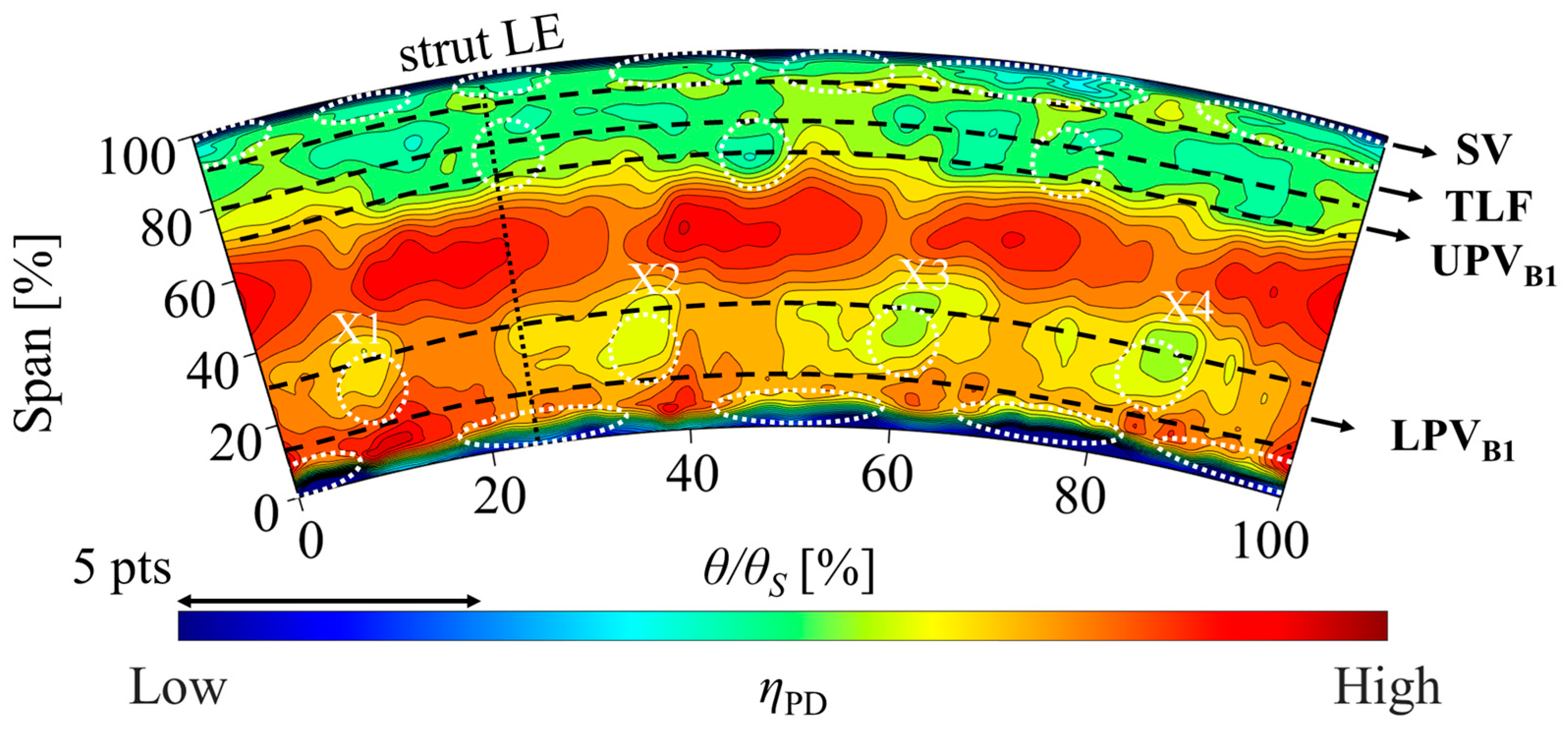

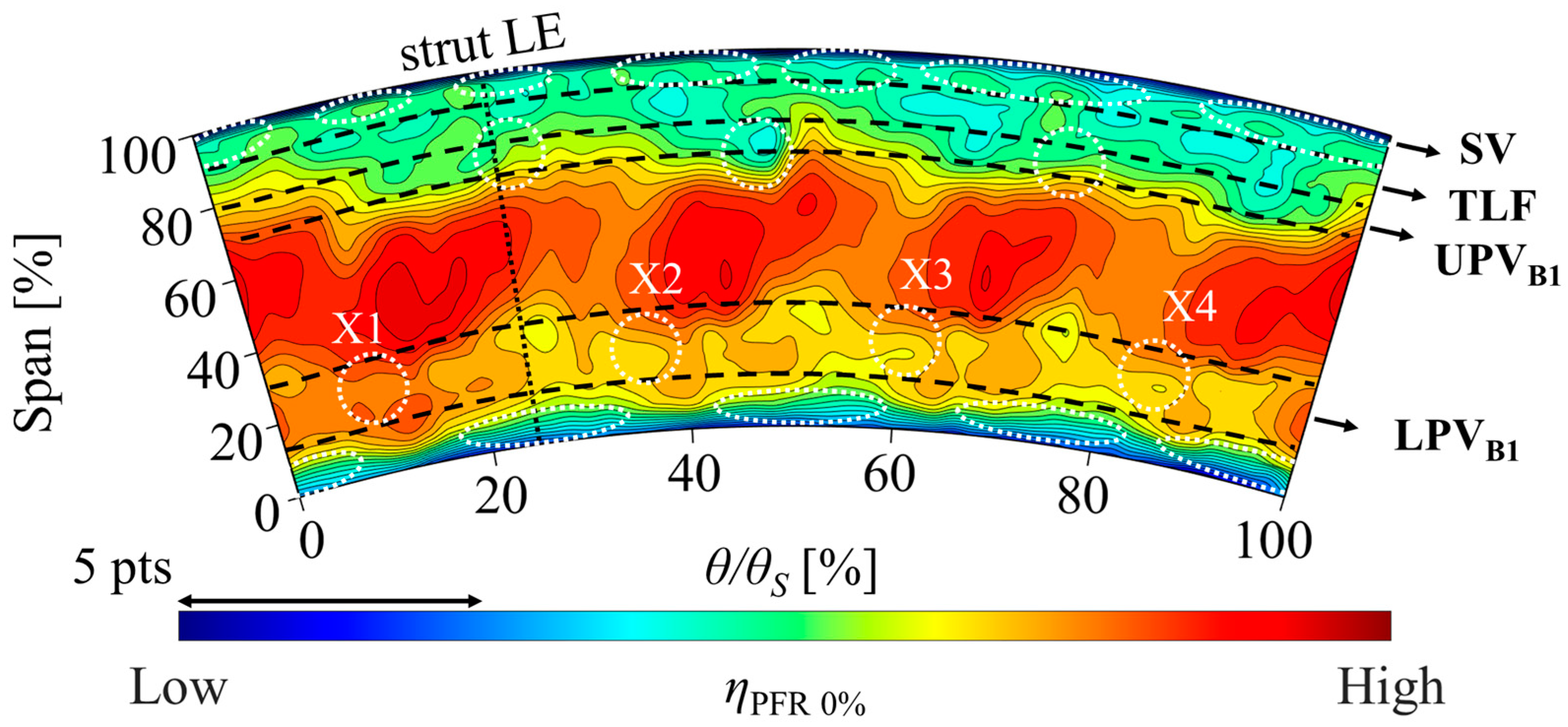

| Annulus Flow | Value | Purge Flow | |
|---|---|---|---|
| Upstream Hub (UHC) | |||
| Upstream Shroud (USC) | |||
| Downstream Hub (DHC) | |||
| Downstream Shroud (DSC) |
Disclaimer/Publisher’s Note: The statements, opinions and data contained in all publications are solely those of the individual author(s) and contributor(s) and not of MDPI and/or the editor(s). MDPI and/or the editor(s) disclaim responsibility for any injury to people or property resulting from any ideas, methods, instructions or products referred to in the content. |
© 2023 by the authors. Licensee MDPI, Basel, Switzerland. This article is an open access article distributed under the terms and conditions of the Creative Commons Attribution (CC BY-NC-ND) license (https://creativecommons.org/licenses/by-nc-nd/4.0/).
Share and Cite
Merli, F.; Krajnc, N.; Hafizovic, A.; Göttlich, E. Performance Evaluation in a Fully Purged High-Pressure Turbine Stage Using Seed Gas Concentration Measurements. Int. J. Turbomach. Propuls. Power 2023, 8, 22. https://doi.org/10.3390/ijtpp8030022
Merli F, Krajnc N, Hafizovic A, Göttlich E. Performance Evaluation in a Fully Purged High-Pressure Turbine Stage Using Seed Gas Concentration Measurements. International Journal of Turbomachinery, Propulsion and Power. 2023; 8(3):22. https://doi.org/10.3390/ijtpp8030022
Chicago/Turabian StyleMerli, Filippo, Nicolas Krajnc, Asim Hafizovic, and Emil Göttlich. 2023. "Performance Evaluation in a Fully Purged High-Pressure Turbine Stage Using Seed Gas Concentration Measurements" International Journal of Turbomachinery, Propulsion and Power 8, no. 3: 22. https://doi.org/10.3390/ijtpp8030022
APA StyleMerli, F., Krajnc, N., Hafizovic, A., & Göttlich, E. (2023). Performance Evaluation in a Fully Purged High-Pressure Turbine Stage Using Seed Gas Concentration Measurements. International Journal of Turbomachinery, Propulsion and Power, 8(3), 22. https://doi.org/10.3390/ijtpp8030022





